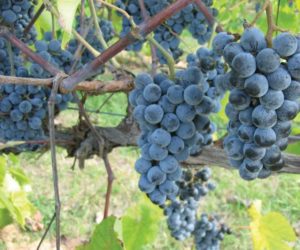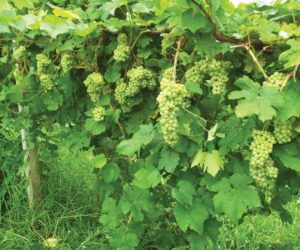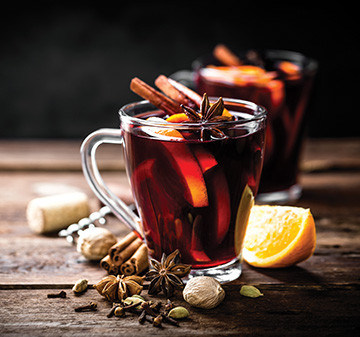
What’s your favorite serving temperature for red wine? Cold? Cellar temperature? Room temperature? How about hot?
Hot, spiced wine has been enjoyed for two millennia or more. When the Roman Empire expanded across Europe, vineyards and wine soon followed. Especially in colder climates, heating and spicing red wine became common practice. As this spicy beverage spread to new areas, regional specialties and national names for it developed. Most commonly “mulled wine” in English-speaking North America (more on “mulled” later), it is vin chaud or hot wine in French. In German-speaking countries, you would most likely encounter the popular winter beverage Glühwein, describing hot, spiced wine as glowing or smoldering. Variations on gløgg or glögg appear in the various languages of the Nordic countries. In many regions, serving mulled wine is associated with the Christmas season, Saint Lucia’s Day on December 13, and the year-end astronomical solstice. In South America, where it might be unpleasantly hot for mulled wine at that time of year, it is served on the opposite side of the calendar. Brazilians enjoy vinho quente during the Festas Juninas, a festival period encompassing the nativity of St. John the Baptist on June 24. Similarly, Chileans toast with their vino navegado on June 23, St. John’s Eve, in celebration of the same saint.
Make Your Own Mulled Wine
Now that you know more about the history, are you ready to make some mulled wine? I have included my personal recipe at the end of this story and I think it’s great, but there’s no reason you can’t make up your own for friends and family as cooler weather is upon us in the Northern Hemisphere. You probably have some homemade red wine in the cellar, spices in the kitchen, and possibly some citrus fruit readily available. World recipe variations provide plenty of range for exploration, although some features appear commonly.
First, although I have mentioned mostly red table wine, that is not the only choice. Versions are also made with fortified wines, white wines, hard cider, and even ale. Spirits are sometimes added in the form of brandy or whisky to make an even more potent beverage. Mulled wine is almost always sweetened, with sugar or honey filling that assignment. Sources cite a range of typical spices, but I’ll call first on one of my favorite culinary reference books, Larousse Gastronomique. That book describes red wine, lemon or orange peel, sugar or honey, and cinnamon, cloves, and mace. Our English name for it, mulled wine, derives from the spices. “Mulling” is an old apothecary term for grinding and thoroughly mixing, as with dried spice mixes. You are certainly welcome to do that in your recipe, or you can follow my lead and just use whole spices and then strain them out for serving.
As with any home winemaking project, you want to achieve both balance and complexity. That means you want a pleasing array of flavors and aromas that blend together for an enjoyable experience. Let’s explore those factors in mulled wine. First, of course, is your base wine. If it is the traditional red wine, you introduce aromas like berries and cherries, plus possible secondary notes like oak, tobacco, or cigar box. There are likely some fruity flavors, most commonly either red or black fruits like plums and cherries. There may be some bitterness, plus astringent “grip” on the palate and tongue from grape or oak tannins. Before you mull it, smell and taste your wine critically to help build your recipe. You will be trying to enhance favorable flavors and aromas and balance out any that could make the finished drink taste disjointed or harsh.
Heat has profound effects on the drinking experience, too. Warmer wine, especially red, may present as harsher when tannins seem to be more prominent. Bitterness may also increase and fruitiness may seem subdued. The wine may seem flat or flabby with the acid not as prominent in a cooler presentation. As alcohol becomes more volatile at higher temperatures, the vapors give the wine a heady impression and obvious spirit-like character, even if no other spirits are added. A sweetener helps balance bitterness and astringency, as well as add apparent fruitiness, which is why sugar or honey is usually added. If you choose honey, you will also be adding aromatic notes that are potentially spicy and floral. Adding citrus peel or juice may add brightness and additional fruity aromas. Finally, the spices you choose will bring their own signature flavor and aromas, building your complexity. As an example, I’ll go through my own recipe.
I like to use a dry, moderately tannic red wine with deep color and a long finish. For this use, I am not looking for the fruitiness of a young red or light delicacy of something like a Pinot Noir. My 2017 Tinta Cão, a red variety often used in Port wine blends, fills the bill perfectly. For my sweetener, I decided on ordinary white table sugar. I wanted to balance any native bitterness and smooth out the astringency, which sugar would do well. I am not particularly fond of the aromas of honey, so I passed on that. I decided for the citrus component that I would use lemon juice in the wine and lemon peel in serving. I have a lemon tree, so I knew I would get fresh flavor and aroma from both.
For spices, I started with one of the most traditional; a cinnamon stick. With flavors and aromas found in many baked goods and desserts, this spice is familiar to just about everybody. It is the dried and rolled bark from one of three species of tropical trees, collectively known as cinnamon trees. Cinnamon from Sri Lanka is often considered the best in the world. Although North Americans use the spice mostly in sweet dishes, in Eastern Europe and Asia it is also found in many savory applications including stews, soups, and roast meat dishes. It has been used in cooking for a long time, including mentions in Sanskrit texts and in the Bible. With its sweet, pungent aroma and hot, spicy flavor notes, I felt it would match nicely with the sometimes “meaty” character of full-bodied red wine.
The next spice in my recipe is clove, another traditional mulling spice. Cloves are another ancient spice, this time the dried flower buds of the clove tree, another tropical tree. They have been used for millennia in sweet and savory dishes and were said to be as popular as black pepper in Europe in the Middle Ages. With strong aroma and flavor, they now appear mostly in a few specific desserts, some stews, and in pickling. With just six of them in my blend, the influence is noticeable but restrained.
For my final spice, I used Jamaican allspice. This one is not always found in mulled wine, but I have used it in sausage making and in pickling and have enjoyed its character. Not an ancient spice of Europe or Asia, the allspice berry is a dried, unripe berry of the tree Pimenta officinalis, native to the Caribbean and Mexico. Jamaica is the most highly regarded producer. In use, allspice carries aromas reminiscent of cloves, cinnamon, and nutmeg, causing some to confuse it with a blend of other spices rather than a single source. Using the dried berries whole assures that you have the real thing. Combined, my recipe yields a satisfying hot drink that is both sweet and tart, with mild tannins tamed with a sweet finish. It is pleasantly spicy, with the cloves kept mild to avoid a dominating aroma.
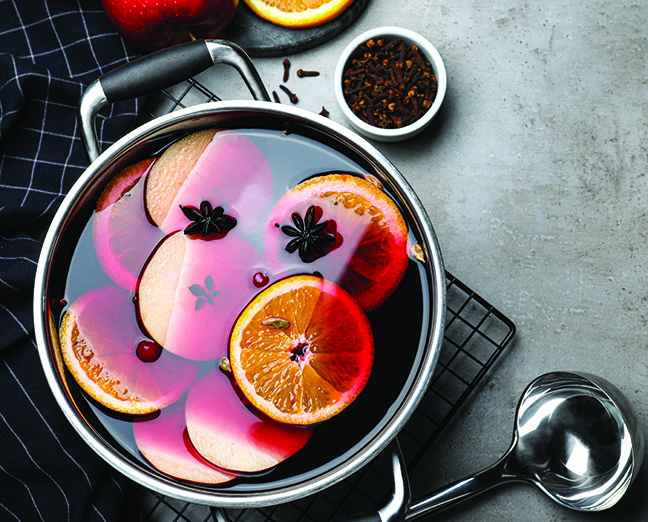
While that is the extent of my mulling spices, I will touch on a few more for your consideration:
Mace: Also traditional in mulled wine, mace has an interesting connection to another spice. Mace is the dried, fibrous outer hull of the nutmeg seed. It can be used as is, but is more commonly ground to a powder for kitchen use. As with some of the others mentioned here, it can be used to good effect in sausages, pickles, pork dishes, and sauces.
Nutmeg: Mace’s counterpart, nutmeg is the peeled, dried seed of the nutmeg tree, native to Indonesia. This spice, too, can be employed in mulled wine and its grated form is sprinkled on top of a number of cocktails. While I love a bit of nutmeg freshly grated on top of a frosty Pink Squirrel (showing my age), most drinkers are probably more familiar with it sprinkled on seasonal eggnog. It is equally at home among the spices for wine.
To make your own distinguished recipe, you may also consider adding ginger, marjoram, cardamom, rosemary, or even galangal. That last one is the aromatic rhizome of one of several Asian plants related to ginger. Seen now mostly in East Asian cuisine, it was common in European cooking in the middle ages and even appears in a 1390 book of English cookery for use in mulled wine.
In writing this article, I learned a number of new things, including from my copy of Larousse, which I’ve had for about 30 years. I knew of author Alexandre Dumas from The Count of Monte Cristo and The Three Musketeers, but I was not aware of his posthumously published nonfiction work, the Great Dictionary of Cuisine. In that book, Dumas gives us a colorful account regarding specialty names for variations on mulled wine. He notes that it may be called “Bishop when made with red Bordeaux (because of its purple color), Cardinal when made with red Rhine wine, and Pope when made with Tokay (white).” So choose your cleric’s robe of choice (or cider or ale), get out those spices, and make a hot, tasty beverage of your own.
Bob’s Christmas Mulled Wine
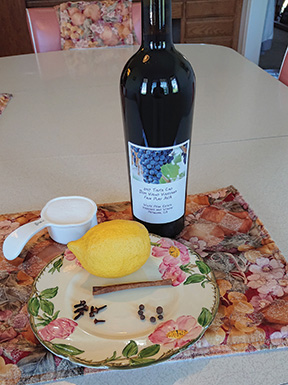
(4 servings)
Ingredients
2 cups homemade dry red wine
½ cup sugar
Juice of ½ lemon
1 cinnamon stick
6 whole cloves
6 whole allspice
Lemon twists for garnish
Step by Step
Combine all but twists in a stainless steel pan. Heat just to a simmer. Strain into heat-resistant glasses or small mugs. Top each with a lemon peel twist.



